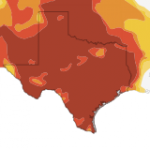The Kids Are All Right: The Lower Colorado Is Low on Oxygen

Photo by Terrence Henry/StateImpact Texas
The Lower Colorado river is suffering from low oxygen levels. Is the drought to blame?
Some high school ecological enthusiasts have collected new data showing the Lower Colorado river ecosystem might be in jeopardy.
The river not only supplies much of Texas with its drinking water, it’s also a cherished destination for summer recreation. But all is not well on the Colorado, and authorities might not have known about the scope of the river’s troubles without the students’ research.
For about 20 years, the Austin Youth River Watch, an environmental education program, has organized groups of teens to monitor the water quality of the Colorado. Every week they check water at different parts of the river and its tributaries. And lately they’ve been getting some unusual readings.
“We’ve been picking up low levels of oxygen over the past few weeks and we’re pretty concerned,” says Brent Lyles, Executive Director of River Watch. He says the group is working with the City of Austin and the Lower Colorado River Authority to figure out why oxygen levels might be dropping. “If not for our students’ work, I’m not sure anyone would know this is happening,” he says.
Less oxygen could spell trouble for fish and other wildlife. And the group has already observed a large number of dead Asian clams in the river, a troubling sign of what happens when oxygen levels get low.
Lyles says this has happened before, “but this one seems to be connected to the low oxygen levels, high temperatures and low flow rates,” he says.
The recent drought meant less water running from creeks and streams into the Colorado. That means less oxygen. Perhaps more importantly, the drought prompted the LCRA to stop its annual releases of water from the highland lakes to rice farmers downstream.
How low are the oxygen levels? River Watch says they’ve observed several points where levels have fallen below 4mg of oxygen per liter of water, even during the day, when levels tend to be higher. Their lowest reading was 2.45 mg/L on Friday. “When levels of dissolved oxygen fall below 4 mg/L for extended periods of time, fish and other organisms experience biological stress, and especially sensitive organisms may not survive,” the group writes on their website.
The LCRA does release water downstream for “environmental requirements.” There are “critical” minimal levels of river flows for environmental needs downstream from the Highland Lakes, all the way down to Matagorda Bay. But is it enough?
“Last year at this time there was a daily, essentially a flushing of water every day coming down the river and this year that’s not there,” says Lyles. “So it’s changing the ecology of the river.”
Lyles says his teams of teenage researchers will keep sending their data on to the City and the LCRA while scientists try to unravel the causes and effects of oxygen depletion.




